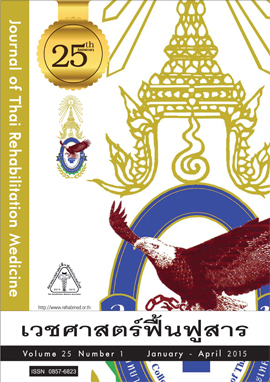การศึกษาลักษณะอุจจาระของผู้ป่วยบาดเจ็บไขสันหลังเรื้อรัง และปัจจัยที่เกี่ยวข้อง
Keywords:
บาดเจ็บไขสันหลัง, การถ่ายอุจจาระ, การถ่ายอุจจาระผิดปกติเหตุจากประสาท, อุจจาระเล็ดโดยไม่ตั้งใจ, spinal cord injury, defecation, neurogenic bowel dysfunction, fecal incontinenceAbstract
The Study of Stool Forms and Related Factors in Chronic Spinal Cord Injured Patients
Khamrueangsri K and Kovindha A.
Department of Rehabilitation Medicine, Faculty of Medicine, Chiang Mai University
Objectives: To study the prevalence of stool forms and related factors in chronic spinal cord injured (SCI) patients with neurogenic bowel dysfunction and compared with the general population.
Design: A cross-sectional study
Setting: Maharaj Nakorn Chiang Mai Hospital Subjects: SCI patients (post-injury > 6 months) and normal persons
Methods: Subjects completed questionnaires including the ISCI core data set, the ISCI basic bowel and QoL data sets, the neurogenic bowel dysfunction score (NBoDS), the Bristol stool chart, the eating and drinking behavior questionnaire. Then, prevalence of stool forms and related factors were analyzed and compared between SCI patients and the normal population.
Results: There were 100 SCI patients (75 males) and 100 normal persons (41 males). Regarding the SCI group, 83% had reflexic bowel (upper motor neuron lesion, UMNL) and prevalence of the stool forms were as follows: 53% hard-lumpy stool, 38% normal stool and 9% loose stool; according to the NBoDS, 33% were severe, 23% had fecal incontinence more than 1 time /month, 66 66 % defecated 2-6 time/week and 68% had duration of defecation less than 30 minutes. The main method to facilitate defecation was using unison enema (44%) and the supplement method was digital evacuation (36%). Stool forms and NBoDS were significantly different between SCI and normal groups. Amount of water intake per day, duration of defecation, perianal skin problems and psychological health satisfaction were significantly related with stool forms (p=0.016, p=0.009, p=0.004 and p=0.018, respectively).
Conclusion: Most of chronic spinal cord injured patients had lumpy stools and needed some methods to facilitate and control defecation. Adequate drinking was related to stool forms and affected duration of defecation, perianal skin problem and psychological health satisfaction.
บทคัดย่อ
วัตถุประสงค์: ศึกษาหาความชุกลักษณะอุจจาระของผู้ป่วย บาดเจ็บไขสันหลังเรื้อรังเปรียบเทียบกับกลุ่มประชากรทั่วไปและ หาความสัมพันธ์ระหว่างลักษณะอุจจาระและปัจจัยที่เกี่ยวข้อง กับการถ่ายอุจจาระ
รูปแบบการวิจัย: การวิจัยเชิงพรรณนา แบบภาคตัดขวาง
สถานที่ทำการวิจัย: โรงพยาบาลมหาราชนครเชียงใหม่ กลุ่มประชากร: ผู้ป่วยบาดเจ็บไขสันหลังมากกว่า 6 เดือนและ อาสาสมัครปกติ วิธีการศึกษา: ใช้แบบสอบถามเพื่อเก็บข้อมูล ได้แก่ ข้อมูล ทั่วไปกรณีบาดเจ็บไขสันหลัง (ISCI cord data set)การถ่าย อุจจาระอิงชุดข้อมูลสากลกรณีบาดเจ็บไขสันหลัง(ISCI basic bowel data set)และแบบประเมินความรุนแรงการถ่ายอุจจาระ ผิดปกติเกิดจากประสาท (neurogenic bowel dysfunction score, NBoDS) ลักษณะอุจจาระอิง Bristol stool chart, การ รับประทานอาหารและน้ำดื่ม,ชุดข้อมูลสากลคุณภาพชีวิตกรณี บาดเจ็บไขสันหลัง (ISCI QoL data set)จากนั้นนำข้อมูลมาหา ความชุกลักษณะอุจจาระ เปรียบเทียบระหว่างผู้ป่วยบาดเจ็บ ไขสันหลังกับอาสาสมัครปกติ และหาความสัมพันธ์ระหว่าง ลักษณะอุจจาระกับปัจจัยที่เกี่ยวข้อง
ผลการศึกษา: ผู้ป่วยบาดเจ็บไขสันหลัง100 คน (ชาย 75 คน), อาสาสมัครปกติ 100 คน (ชาย 41 คน) ในกลุ่มผู้ป่วย บาดเจ็บไขสันหลัง ร้อยละ 83 กลุ่มรอยโรคไขสันหลังเหนือส่วน ใต้กระเบนเหน็บ (upper motor neuron lesion, UMNL) พบลักษณะอุจจาระดังนี้ ร้อยละ 53 อุจจาระแข็ง, ร้อยละ 38 อุจจาระนุ่ม และร้อยละ 9 อุจจาระเหลว; ร้อยละ 33 มีความ ผิดปกติการถ่ายอุจจาระรุนแรงมาก, ร้อยละ 23 ถ่ายอุจจาระ โดยไม่ตั้งใจมากกว่าเดือนละครั้ง, ร้อยละ 66 66 ถ่ายอุจจาระ สัปดาห์ละ 2-6 ครั้ง, ร้อยละ 68 ใช้เวลาในการขับถ่ายอุจจาระ น้อยกว่า 30 นาที, ร้อยละ 44 ใช้การสวนทวารด้วยน้ำยายูนิสัน เป็นการถ่ายอุจจาระหลัก และร้อยละ 36 ใช้การล้วงควัก อุจจาระออกเป็นวิธีการเสริม เมื่อเปรียบเทียบระหว่างผู้ป่วย บาดเจ็บไขสันหลังกับอาสาสมัครปกติพบว่าลักษณะอุจจาระ และระดับความรุนแรงของการถ่ายอุจจาระที่ผิดปกติมีความ แตกต่างกันอย่างมีนัยสำคัญทางสถิติ ปัจจัยที่มีผลต่อลักษณะ อุจจาระอย่างมีนัยสำคัญทางสถิติได้แก่ ปริมาณน้ำดื่มต่อวัน, ระยะเวลาที่ใช้ในการถ่ายอุจจาระ, การมีปัญหาผิวหนังรอบ ๆ ทวาร และความพึงพอใจด้านสุขภาพจิต (p=0.016, p=0.009, p=0.004 และ p=0.018 ตามลำดับ)
สรุป: ผู้ป่วยบาดเจ็บไขสันหลังเรื้อรังส่วนใหญ่มีลักษณะอุจจาระ แข็ง และต้องใช้วิธีการช่วยในการถ่ายอุจจาระ ปริมาณน้ำดื่ม ต่อวันมีความสัมพันธ์กับลักษณะอุจจาระ ซึ่งส่งผลต่อระยะเวลา ที่ใช้ในการถ่ายอุจจาระ, การมีปัญหาผิวหนังรอบ ๆ ทวาร และ ความพึงพอใจด้านสุขภาพจิต






